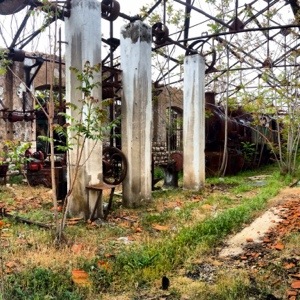After a day at the AUB farm (AREC DAY), a few friends and I took a detour to the Rayak Train Station, located in the Bekaa Valley past the Rayak Air Base. Rayak (pronounced Riya’) is home to one of the many abandoned train stations (and a factory) of Lebanon. The line, that used to run from Beirut to Damascus, was the 1st railway built in Lebanon back in 1891. This was before the country was “independent” and was still under Ottoman rule. The dilapidated remains of the station are frozen in time. It’s a lot like how you would imagine a war zone after a ceasefire; everything is where it was before the war, only it’s aged, rusted, and beautifully decayed.
The caretaker on site there told us that a permission slip from Mar Mikhael in Beirut was needed to access the grounds but we pleaded and he allowed us to roam around a bit while advising us not to enter any of the buildings because it was dangerous due to the rain. When we asked him why the supposed project for a Rayak Train Station Museum seemed to be put on hold, he seemed quite discouraged. The way he put it was, the project, though ambitious and worthy, needs financing and the people in charge of our country aren’t willing to fork it over for something that isn’t seen as a priority. It seems that if this project were to ever see the light of day, it would need some wealthy private investors. It is sad that our country does not seem concerned with the preservation of such sites – remnants of our rich history and grounds related to our past. If there are no plans of renovation or innovation when it comes to public transportation, we should at least cherish the graveyards of days when we did have such machinery running along our coast.
There has been talk of a museum, a documentary, and even getting the trains back on track. Unfortunately, talk’s all that seems to have happened since such things were written in a TimeOut Beirut article almost 3 years ago. Elias Boutros Maalouf from Ecuador (familial roots from Rayak) put together a study called “The Rayak Train Museum Proposal” in 2009. The document, in French, English, and Arabic, describes a plan for a museum for all the Lebanese railways. You can check out the whole thing here. Some tidbits from the proposal:
- “By 1912, it was a vital cog in an intercontinental rail system that spread throughout Europe and Asia and, by the 1940s, linked Europe and Africa.”
- “In the beginning of August 1895, the first train took off from the port of Beirut to Rayak railway station.”
- “Rayak was famous for having one of the biggest train factories in the world at that time. It was later well known for designing and reassembling old steam engines that worked on charcoal to work on fuel.”
- “In 1976, the railway was shut due to the civil war, ending more than 85 years of success and achievements.”
- “In World War II, this factory was used as a military base in which military weapons were fixed. At that time a group of engineers from both the train factory and Rayak’s Military Airbase were assigned to build airplanes for the French military. Some of the airplane parts were manufactured and designed in Rayak’s train factory. They were then taken to Rayak airport to be assembled to their new chassis, and, Rayak’s first airplanes conquered the sky.”
I contacted Mr. Maalouf to ask what has come of this project since there was no recent news of it. Apparently, he has completed the Lebanese Railways documentary but he’s still waiting for the opportune moment to release it. Three weeks ago, Train/Train, the NGO he co-founded, met with Gaby Layoun, the Minister of Culture, to discuss the project – however, they have yet to hear back from the Ministry since. Officials from the Ministry of Transport, on the other hand, visited Rayak last week with a freight truck company to see to plans of a truck hub at the station – an effort that Train/Train would like to thwart. Train/Train Lebanon are “working on preserving the past and building the future of the Lebanese Railways.” You can follow them on Twitter and check them out on Facebook.
Another site to check out is CEL – Chemin de Fer de l’Etat Libanais; it has information on the railways including timetables, postcards, and photographs all collected by Børre Ludvigsen.









Pingback: Rayak Train Station - Blog Baladi
very nice… and i also present to you my part also of rayak train station on this link:
http://ghazayel.wordpress.com/2012/04/23/riyaak/
Pingback: 15 Top Links From Around the Web | Urban Ghosts |
Pingback: Bambi’s Soapbox on Urban Ghosts | Bambi's Soapbox
Pingback: Lebanese railway revival to be studied - Blog Baladi
Pingback: 8 Things We Can Look Forward To | Bambi's Soapbox
Pingback: Lebanese railway revival to be studied | Lubnaneyoun | لبنانيون
Pingback: 15 Top Links From Around the Web | Urban Ghosts |
Pingback: Bambi’s Soapbox: Top 5 of 2013 | Bambi's Soapbox
Pingback: Afternoons with the Sursocks: Sawfar & Beirut | Bambi's Soapbox
Pingback: Bambi Recommends: Los Angeles Spring 2018 | Bambi's Soapbox